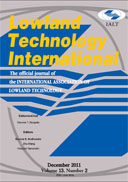Current issue
Displaying 1-7 of 7 articles from this issue
- |<
- <
- 1
- >
- >|
Research Papers
-
2016Volume 18Issue 1 Pages 1-8
Published: June 10, 2016
Released on J-STAGE: August 01, 2016
Download PDF (1823K) -
2016Volume 18Issue 1 Pages 9-22
Published: June 10, 2016
Released on J-STAGE: August 01, 2016
Download PDF (1862K) -
2016Volume 18Issue 1 Pages 23-30
Published: June 10, 2016
Released on J-STAGE: August 01, 2016
Download PDF (2360K) -
2016Volume 18Issue 1 Pages 31-40
Published: June 10, 2016
Released on J-STAGE: August 01, 2016
Download PDF (1101K) -
2016Volume 18Issue 1 Pages 41-50
Published: June 10, 2016
Released on J-STAGE: August 01, 2016
Download PDF (1035K)
Technical Notes
-
2016Volume 18Issue 1 Pages 51-58
Published: June 10, 2016
Released on J-STAGE: August 01, 2016
Download PDF (1585K) -
2016Volume 18Issue 1 Pages 59-64
Published: June 10, 2016
Released on J-STAGE: August 01, 2016
Download PDF (951K)
- |<
- <
- 1
- >
- >|
